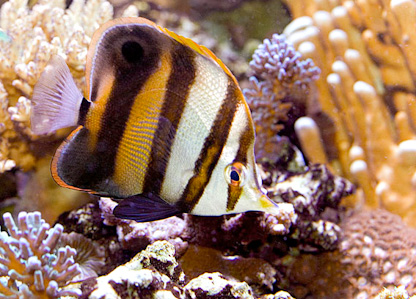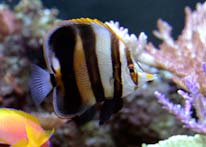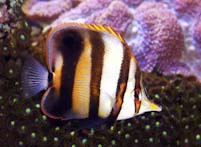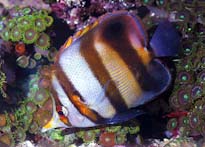 Fish Profile - Chelmon Muelleri
Fish Profile - Chelmon Muelleri
Fish Profile - Chelmon Muelleri
Meuller's Butterflyfish - Chelmon Muelleri
Mueller's Butterflyfish, Chelmon muelleri |
 |
 |
 |
 |
| Common Name: | Mueller's butterflyfish, Blackfin coralfish, or Muller's coralfish |
| Scientific Name: | Chelmon muelleri (Klunzinger, 1879) |
| Size: | Up to 8 inches (20.5cm) |
| Distinguishing Features: | Like most from the genus of Chelmon, the Meuller's butterflyfish have an elongated tubular snout that is used to pry into small crevices looking for prey. They have four vertical bars on their body. A false-eye spot is located on the rear dorsal fin to aid in escaping predation. |
| Distribution: | Pacific Ocean: Found exclusively near coral reefs and estuaries of Northern Australia. |
| Natural Habitat: | As benthic feeders they prefer mud bottoms of estuaries and coastal reefs. Indigenous to Northern Australia only. |
| Feeding Requirements: | It is not difficult to imagine the feeding requirements of this species. Considered a benthic feeder its long snout is perfect for hunting small sessile invertebrates. Will nip at featherdusters and possibly will eat clams and Aiptasia. Upon receiving this species it is advisable to get it feeding on live mysis, blood worms, or other similar food. Initially they may refuse commerical feed. Therefore they should be fed a variety of live foods and slowly converted to frozen or flakes. Nutrition is a concern with this species and a variety of foods should always be offered. |
| Difficulty Rating: (1 = easy - 5 = hard) |
The difficulty rating of 4 out of 5 is deserved. Due to stress from shipping, their malnurishment and possible infections may have the greatest impact on survivability in captivity. The most difficult aspect of this specie is having it feed regularly when initially received. Once established and regularly feeding in a stable high-water quality aquarium they will last for many years. |
| Aggressiveness Rating: (1 = shy - 5 = nasty) |
The Mueller's butterflyfish is a model citizen and receives an aggressive rating of 2 out of 5. Similar to that of the Copperband, they are shy and timid feeders. When housing with larger more aggressive species, it is advisable to introduce these animals first. |
| Captive Requirements: | Inactive at night, this animal spends its day foraging around the open reef. In captivity this should be no different and the Mueller's butterflyfish deserves a tank of no less than 100 US gallons (380 liters). This animal can reach sizes of 8 inches and ideally should be kept in 150 US gallon aquariums or larger (570+ liters). |
| Reef Tank Compatibility: | This fish fits the profile of many Chelmon species. It should be introduced with caution similarly to that of Chelmon rostratus (Copperband butterflyfish) and Chelmon marginalis (Margined coralfish). |
| Personal Experience: |
I once read an article that referred to it as the Copperband's, Chelmon rostratus, 'ugly stepsister'... Now maybe it's me, but with its burnt orange stripes alternating on a mother-of pearl background, I'm already sold on the Mueller's in terms of asthetic appeal. But add the electric blue and yellow specklings within its fins and flanks, its foreshortened snout, amusing personality, and refreshing hardiness and it's absolutely no contest. -Michael G. Moye |
| Further Reading: | Fishbase.org - Chelmon muelleri |
Note: All of the above information has been compiled from various sources and should be used as a guideline, not a hardfast rule. Use caution when selecting animals for your own tank and research as much as possible before purchasing any animals. Remember that certain corals and fish are very hard to keep if their special requirements are not met. The information contained here is to help you make an informed decision. The author assumes no responsibility for any consequences that may arise from the use of this information.


